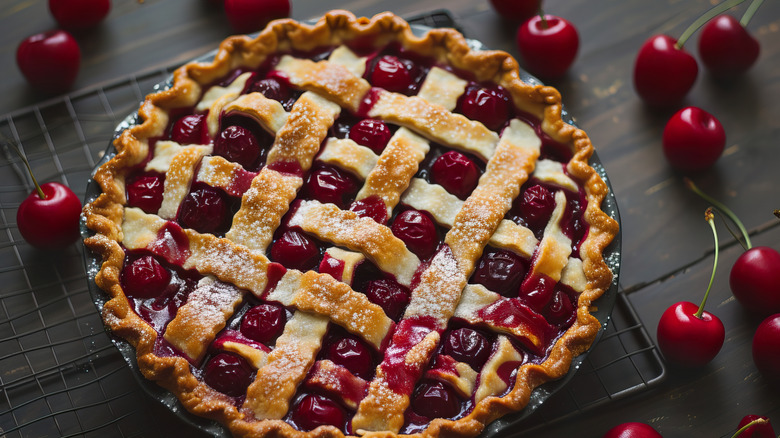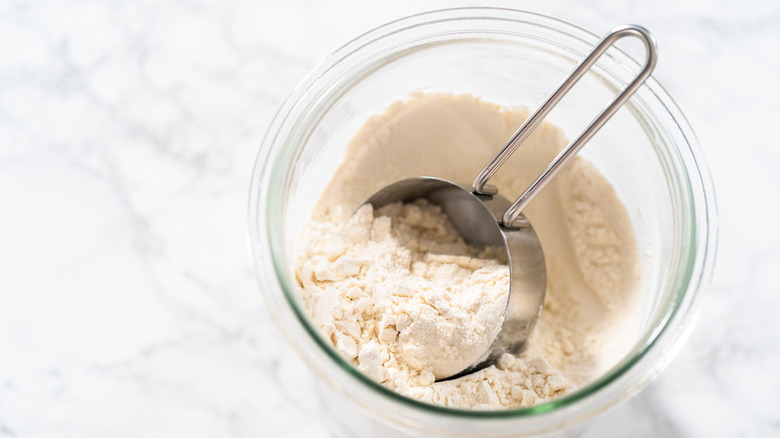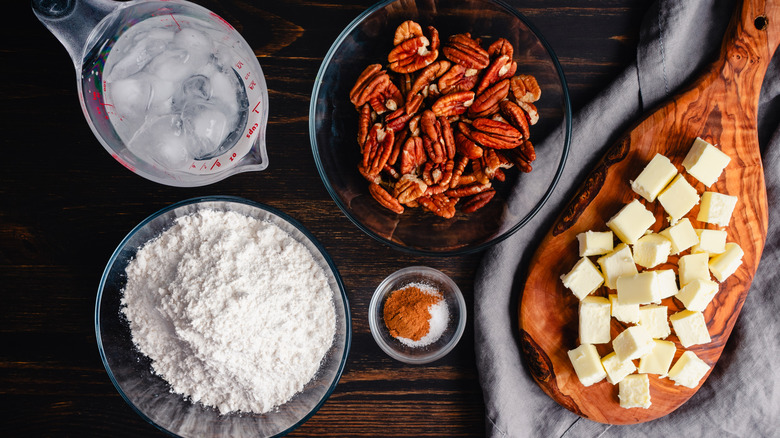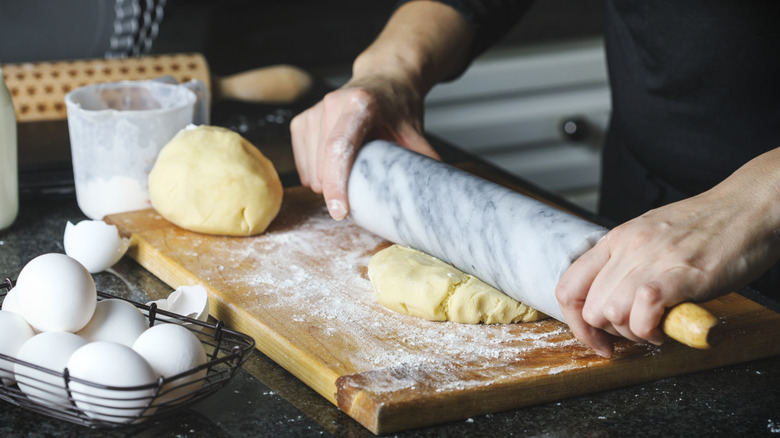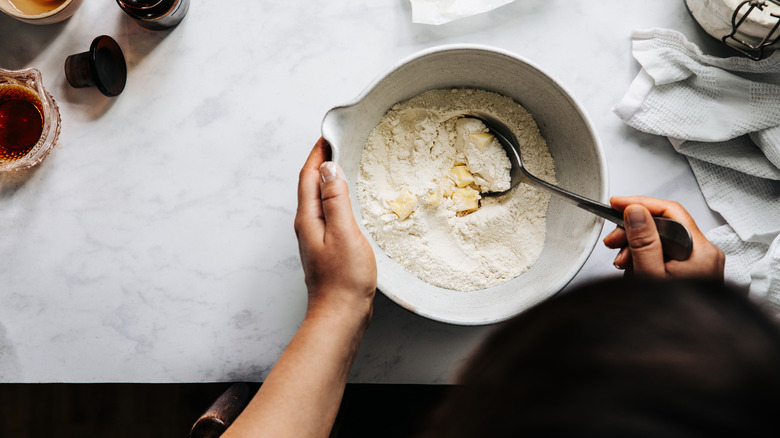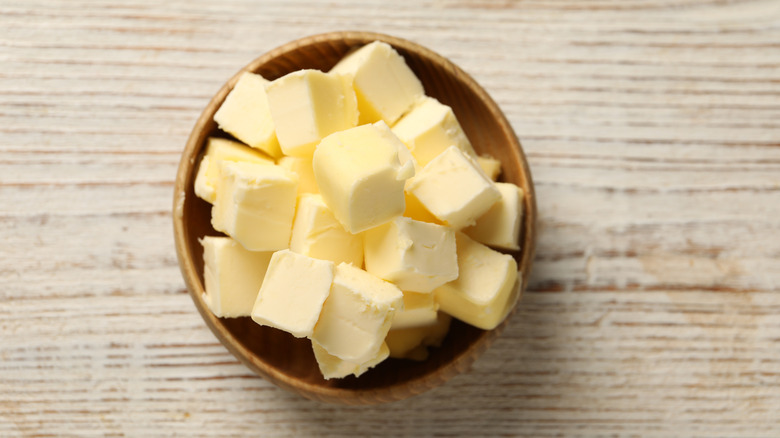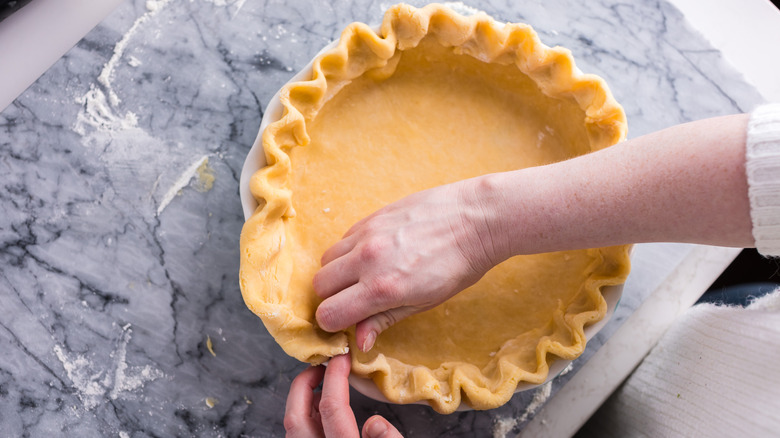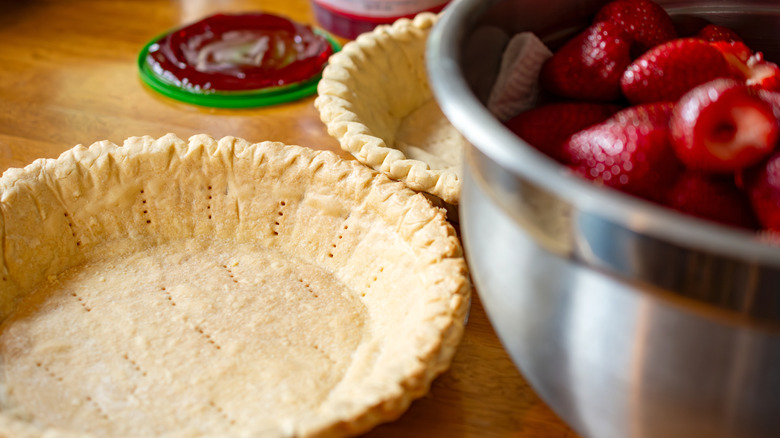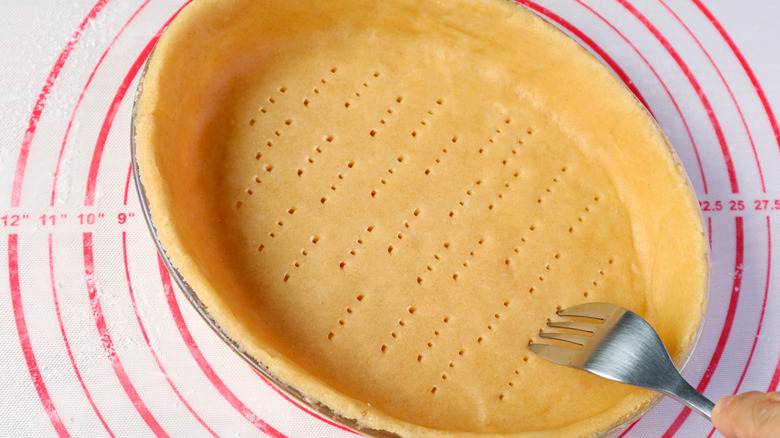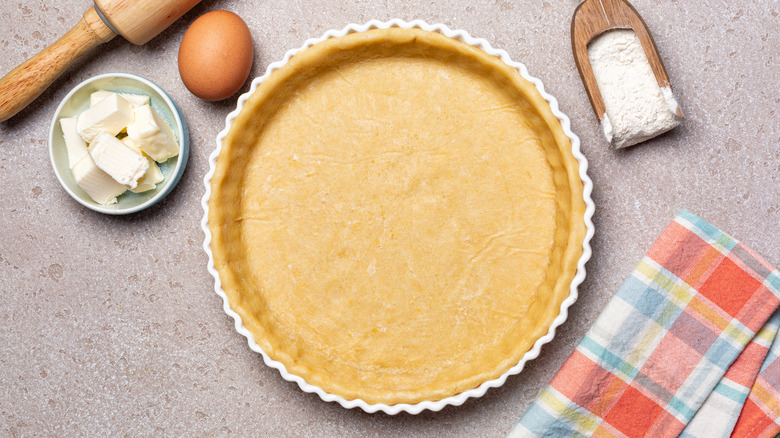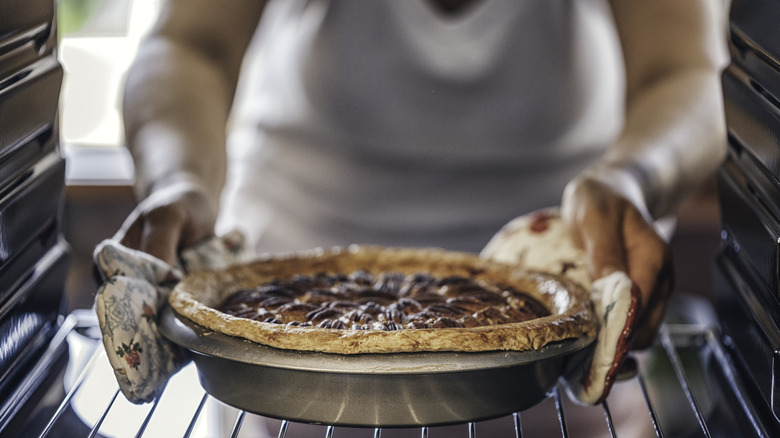10 Common Mistakes To Avoid With Homemade Pie Crusts, According To The Experts
We may receive a commission on purchases made from links.
It's often said that cooking might be an art form, but baking is a science. That is especially true when it comes to pies, where the balance of ingredients and precise steps are key for the perfect crust. Don't worry, we've all been there, ready to end the evening's meal with a delectable pie, only to find the crust has come out bland, burnt, tough, or tasteless.
Pie crust doesn't have to be any of those things, and if you've noticed a trend of your friends and family eating all the filling but leaving behind the crust, there may be an easy fix for that. There's no reason your pie crust can't be delicious. We wondered about some of the most common but overlooked mistakes that might just be ruining your pie crust. For the inside scoop, we reached out to a few experts.
They did not disappoint. We spoke with Adriano Zumbo of "MasterChef Australia," Netflix's "Zumbo's Just Desserts," and "Sugar Rush," and founder of Zumbo Skool. He's also the author of some incredible cookbooks, including "Zumbo: Adriano Zumbo's Fantastical Kitchen of Other-Worldly Delights" and "Zumbo Files: Unlocking the Secret Recipes of a Master Pâtissier." We also spoke with James Northington, the chef who's whipping up some of the most incredible custom desserts in Las Vegas over at From Scratch by James. They gave us insights into some of the most common mistakes that amateur bakers make with their pie crusts and some ideas on how to fix them.
You didn't measure your flour correctly
There's a good chance that you've been measuring flour wrong this whole time, and if that's the case, it could be the source of a number of pie crust-related problems. That's according to pâtissier Adriano Zumbo, who told us just how important it is to measure flour correctly. If you don't? "There is a big difference in your final product if there's too little or too much flour; [it] can cause liquid, runny mixes, dry, crumbly mix textures, doughs that under-develop, doughs that never form, raw centers, [and] recipes that fall apart and are fragile."
In other words, precise flour measurements are a huge deal, and the wrong amount can be the source of a number of problems. If you're measuring flour wrong, what should you be doing?
First, invest in a digital scale. They're not expensive, and it's almost a guarantee that they'll become one of the most important tools you have in your kitchen. There are plenty of options out there, from this Amazon Basics Digital Kitchen Scale that can weigh anything up to 11 pounds to this larger Nicewell Food Scale, which can handle up to 22 pounds. Then when making a pie crust, weigh out your flour to get an exact amount instead of using a measuring cup. Depending on how dense or loosely packed your flour is, you can get wildly different amounts using measuring cups, and that can sabotage your crust before you even start mixing.
Your recipe wasn't properly balanced
One of the great things about the modern world is that there's no shortage of seriously delicious pie recipes available at your fingertips. Whether you're looking for a simple Dutch apple pie recipe, an easy peanut butter pie to satisfy the sweet tooth of any Reese's lover, or a light and fun lemon meringue pie, a ton of options are out there. Still, there's a reason that the tried-and-true recipe that's been passed down through families or among office coworkers is a big deal: It works.
Not all recipes are created equal. According to what pâtissier Adriano Zumbo told us, an improperly balanced pie crust recipe is, well, a recipe for failure. He cited a number of potential problems, including recipes that called for too much or too little of the key ingredients: butter, sugar, water, and flour. Different sorts of imbalances can cause different problems. Let's say your recipe has too much sugar. "The crust can burn quicker at temperature due to caramelization and Maillard reaction," Zumbo explained.
If you're working with a recipe that doesn't have the right balance of all those things, you're going to end up with a cracked, funky-looking (and funky-tasting) pie crust. Want a foolproof pie? Start with a trustworthy pie crust recipe, and that might just mean pulling out that top-secret family recipe that's been handed down through generations. If it works, don't change it!
Your ingredients (and your hands) aren't cold
Here's a mistake that goes back to the idea that baking is a science, and it has to do with temperature. We're not talking about the oven — not yet, at least. We're talking about ingredients. When we spoke with Las Vegas-based custom dessert chef James Northington, the very first thing he stressed was the importance of keeping your pie crust ingredients cold. Warm butter, he said, will leave you with a tough and chewy crust, while cold butter will retain some structure until you bake your crust. That's when those incredible, flaky layers develop. Northington noted that the temperature doesn't apply just to your ingredients.
He told us that he sees many people make the mistake of using warm tools that will affect the temperature of your butter and dough, and that means bowls and even your own hands. Your body temperature can definitely start to warm and melt that butter. But he also gave us a brilliant solution.
"Put a bigger bowl of ice under your dough bowl so everything stays cold while kneading it together," he said. Temperature will solve many of your pie-crust related problems, and here's some food for thought: If you're working with a dough that doesn't seem to be coming out quite right, consider temperature before adjusting the recipe in any way.
You overworked the dough
It's an understandable urge to want to mix any dough completely and thoroughly until all the individual ingredients disappear and you have what looks like a beautiful, smooth dough. The truth is, though, that you could be sabotaging your pie crust by doing that, and here's why: If you work your dough to that point, you're overworking it. You should still be able to see some lumpy bits, and don't worry — when you roll out the crust, that will actually finish bringing the whole thing together.
Pâtissier Adriano Zumbo told us exactly what happens when you work the dough too much. He explained that it all has to do with gluten. "Overworking the dough [is] where the gluten network gets too tough and developed and shrinks rapidly, causing unevenness and cracks as the tight dough bursts open," he explained.
That's a mistake that there's just no coming back from, and once you've worked the dough past the point of no return, you're probably going to have issues. And it's easy to do, especially when you're in a hurry around the holidays, which might be your most likely season for pie-baking. We do have a tip for you, though, and it's one that will help you slow down and pay closer attention to each and every step: Make your pie dough in bulk, freeze it, and remain stress-free.
You're not working your butter correctly
The perfect pie crust is light, flaky, and buttery, and it's going to accentuate the filling, not ruin it. When we spoke with James Northington over at From Scratch by James, he told us that one of the most common mistakes he sees amateur bakers make is not using butter correctly. He says that it's important not to melt your butter. While temperature plays a role in that, it's only one part of the equation.
Northington says that using cubed butter is the key to a flaky crust. Why cubed? That way, the butter will retain some structure and stay whole. That also goes back to why you shouldn't overwork the dough because that will also cause you to lose some of the structure. When the water in butter evaporates during baking, that encourages the development of the layers that you want to see in a really incredible crust.
And here's another important tip: You'll need to use the right butter. You may have heard all about the differences between the taste of Irish butter (like Kerrygold) and American butter. Even if you reach for Kerrygold for your toast, it's good old American, grade AA, unsalted butter that's the best for pies. Irish butter tends to have more butterfat, and since it's lower in water content, it doesn't evaporate as well and leads to a pie crust that's greasy instead of flaky. Now you know!
You didn't line the pan properly
Transferring that perfectly smooth pie crust into the pan you're going to be baking it in can be a challenge. According to what pâtissier Adriano Zumbo told us, this is one of the places that many amateur bakers stumble. The dough should be uniform and smooth against the bottom of the pan. If you end up with any air bubbles or spaces, it could cause your entire crust to shift, sag, and try to fill those spaces as it cooks.
Zumbo says that happens because as your crust heats, it melts just a little bit. That causes it to flow into any air pockets that might be lurking, unseen beneath the crust. That's why when you end up pulling it from the oven, you find your carefully prepared side crusts are no more.
The good news is that there is a trick to transferring your delicate pie crust once it's rolled out to ensure it's properly positioned in your pie pan. Instead of trying to move the whole flat sheet or put it into the pan before flipping it — which is exactly how you get those air pockets — fold it first. You'll need to have a gentle touch, but if you fold it in half and then in half again, you'll have a roughly triangular piece of dough that you can lift, center into your pie tin, and slowly unfold. Make sure there are no gaps beneath your crust, and you'll be golden.
You added a liquid filling to an unbaked crust
A soggy pie crust is just as bad as a burnt one, and there are a few mistakes that you could be making that sabotage your pie before it even goes in the oven. When we asked pâtissier Adriano Zumbo about some of the most common mistakes he saw being made with pie crusts, he told us that adding a pie filling with a high liquid content to an unbaked pie crust is setting yourself up for failure.
"Baking liquid batters in an unbaked crust [means] the moisture affects the surface contact of the dough, which doesn't cook properly," he explained. And it makes sense. Some pie recipes — like this easy strawberry pie — rely on a pie crust that's cooked first to ensure that it can stand up to the filling.
It can be difficult to know whether you'll need to pre-bake your pie crust without a filling, which is also called blind baking, but a really good recipe will tell you — and that's a great sign of whether or not you're working from a recipe that's legit. Some firm fruit pies don't necessarily need to be put into pre-baked crusts, but if you're making a custard pie or any pie that has a filling that's on the liquid side of things, look for those blind baking instructions. If you don't see them, we'd even suggest finding another recipe.
You're not blind baking properly
If you need to blind bake your pie crust, it's a pretty straightforward process. That's not to say that it's impossible to make mistakes here, but fortunately, From Scratch by James chef and baker James Northington gave us a head's up to one of the biggest mistakes that he sees: not poking holes in the dough before putting your pie crust in the oven.
Northington explained that poking holes in the surface of the crust allows for proper cooking. If you find that your pie crusts tend to have air bubbles forming or that just end up too flat, this might be the problem. If there's one thing that we love more than figuring out how to avoid problems, it's easy fixes.
When it comes to blind baking, that's a process that's easy enough. After lining your pie tin with the dough and poking holes in it, fill the tin with a layer of dried beans or reusable baking beans. If you're doing a lot of baking, it's definitely worth investing in some baking weights, like these ceramic pie weights from FurRain. Bake the crust with the pie weights for about 15 minutes, then remove the weights, and add another five minutes of bake time before adding your filling.
You stored your crust in humid conditions
Chilling the dough for your pie crust is a crucial step in getting an amazing pie, but the professionals also recommend that you don't leave your pie dough to sit in the refrigerator overnight. Properly storing your pie crust if you're planning on making it ahead of time is crucial, and according to what pâtissier Adriano Zumbo told us, storing your dough in a way that exposes it to moisture is a surefire way to end up with a soggy crust.
It makes sense, right? And there's a good chance that it just might be one of those small things that you didn't even think about until he pointed it out. If you're going to chill your dough in the fridge, you should definitely wrap it in cling film to make sure it's not absorbing any extra moisture and throwing off the balance of the recipe you've worked so hard to maintain.
Also, if you're making dough ahead, it's better to freeze it than to let it sit out. The good news is that pastry crust freezes really well, and if you're planning on making a lot of pies for a holiday dinner or bake sale, you can also freeze whole pies. That only works for some fillings, though, and while you shouldn't try this with custard pies, it's entirely possible that sealing dough with cling film and popping it in the freezer will keep it from absorbing moisture and getting soggy.
Your oven is too hot
Here's another strange thing that you may have never considered: How do you know that your oven temperature is accurate? Do you just turn it on to whatever temperature the dials say and run with that? You should be checking your oven temperature every three to six months with an actual thermometer. The good news is that they're easy to source and very affordable: This Taylor Large Dial Cooking Thermometer is calibrated to work in ovens and grills, and it'll give you an accurate reading of your actual oven temperature.
Different parts of your oven might heat to different temperatures as well, so taking a series of readings will help you determine which part gets to the temperature you want for pies. That's potentially a huge deal. Pâtissier Adriano Zumbo told us that if your oven is too hot, you're going to end up with a less-than-stellar pie crust.
"Oven temperature is crucial to bake the crust to that perfect color, flavor, and cook through to the finish," he explained. "If too high — and the pie [isn't] turned during baking — edge browning and burning is more prominent." That's especially a danger with recipes that have a high sugar content, as high temperatures will kick off the Maillard reaction. You want that to happen while you're cooking some foods — it's what causes that delicious caramelization on meats and roasted vegetables — but it's not what you want to happen to your pie crust.
